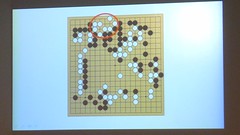
Clint
Hocking, Creative Director at LucasArts, gave a talk at UCSC last week about
meaning, dynamics and games. He took a stance in asking HOW games mean
(following Chris Hecker) rather than WHAT they mean. "When we know how
they mean, maybe then we can speculate on what a specific game might
mean."

Clint
explained the Kuleshov effect to us, showing how the exact same image takes on
different meanings depending on what context it is shown in.
He then
went on to talk about Brathwaite's game Train, in the Mechanic is the Message
series, where the train cars are destined to the camps of the Second World War.
He asked us to close our eyes and play Tetris in our heads pretending that the
boxes are train cars. He hummed the tetris music for us.
This was
extremely powerful.
Different
strategies are possible to obstruct the cars going to their destinations: leave
one free spot in each Tetris-row would save as many as possible for example.
By this
example he wanted to illustrate how the expression "only a skin" is a
reduction when we talk about fictional themes for a game. Changing the
fictional theme but not the mechanics of a game is more than a skin because it
can change the dynamics of a game, that is, how it is played. (When saying
'dynamics' and 'mechanics' Clint used the terms as used in Hunicke's MDA model.)
Clint's
next example was the novel "The Masters of Go" by Kawabata Yasunari
that describes a Go match where the game play express the tension between
modern and traditional Japan. We looked at the end-state of the game, which was
extremely interesting. I think this is one of the best examples one can point
at when arguing that not only creating a game can be art - playing games is also
a form of art. In this case the art is created by two players together. I
remember an anime series I watched when I spent a guest research period in
Tokyo - Hikaru No Go - that anime series expressed a similar view on go-playing
as art. The perfect game.

Clint
argued that it can be difficult to say what the games Tetris or Go mean, but
that it is possible to tell what a certain instance of playing the game can
mean. Like in our combination of Tetris with train, and in the Go-game
described in the Masters of go.
This was
one of the best talks I've heard this year, it's up there at the top together with
Brian Moriarity's talk at GDC this year. Thank you Clint :)
